Introduction
The realm of Linux help desk software presents a myriad of choices, each tailored to meet the diverse demands of organizations ranging from small startups to large enterprises. As businesses increasingly recognize the critical role of efficient customer support in driving satisfaction and loyalty, the selection of the right help desk solution becomes paramount.
This article delves into the various options available, including both open-source and commercial software, highlighting their unique features, pricing structures, and the importance of aligning these tools with organizational needs.
By exploring key considerations such as:
- Performance metrics
- User satisfaction
- Best practices for selection
organizations can navigate the complexities of the help desk landscape and ultimately enhance their operational efficiency in an ever-evolving digital environment.
Overview of Linux Help Desk Software Options
The scenery of support applications includes a varied selection of choices, spanning from open-source alternatives like OTRS and Request Tracker to commercial products such as Freshservice and Zendesk. Each category serves distinct organizational needs, catering to a spectrum that spans from small businesses in search of cost-efficient alternatives to large enterprises demanding robust features and scalability. Open-source tools frequently stand out due to their inherent flexibility and customization capabilities, enabling organizations to tailor solutions to their specific workflows.
Conversely, commercial products typically provide more extensive support and streamlined user experiences, which can enhance overall operational efficiency.
However, users often encounter difficulties when selecting a distribution, particularly regarding hardware support and program compatibility. This complexity can impact the overall user experience, making it essential for organizations to carefully evaluate their options. The increasing demand for open-source security applications, which surged by 18% in 2024 amid escalating cybersecurity threats, underscores the importance of linux help desk software as a solution for maintaining robust IT infrastructures.
As Saisuman Revankar observes, "The demand for open-source security software rose 18% in 2024, driven by increased cybersecurity threats," emphasizing the critical role these solutions play.
Furthermore, anecdotal evidence suggests that many users transitioning from Windows to an alternative operating system report satisfaction with their new systems, highlighting the viability of this option as a reliable substitute. This shift is supported by a half percent increase in desktop usage over the past month, indicative of a broader acceptance in the market.
Organizations must consider these factors when choosing a support solution, aligning their selections with operational requirements and budgetary limitations. The vibrant community surrounding the operating system contributes to ongoing innovation, as seen in the case study titled "Community Support and Innovation in the operating system," which illustrates how the open-source nature of the platform fosters a collaborative environment that enhances its competitiveness. By comprehending the advantages and disadvantages of both open-source and commercial support applications, organizations can better position themselves to utilize the right linux help desk software to address their specific challenges.
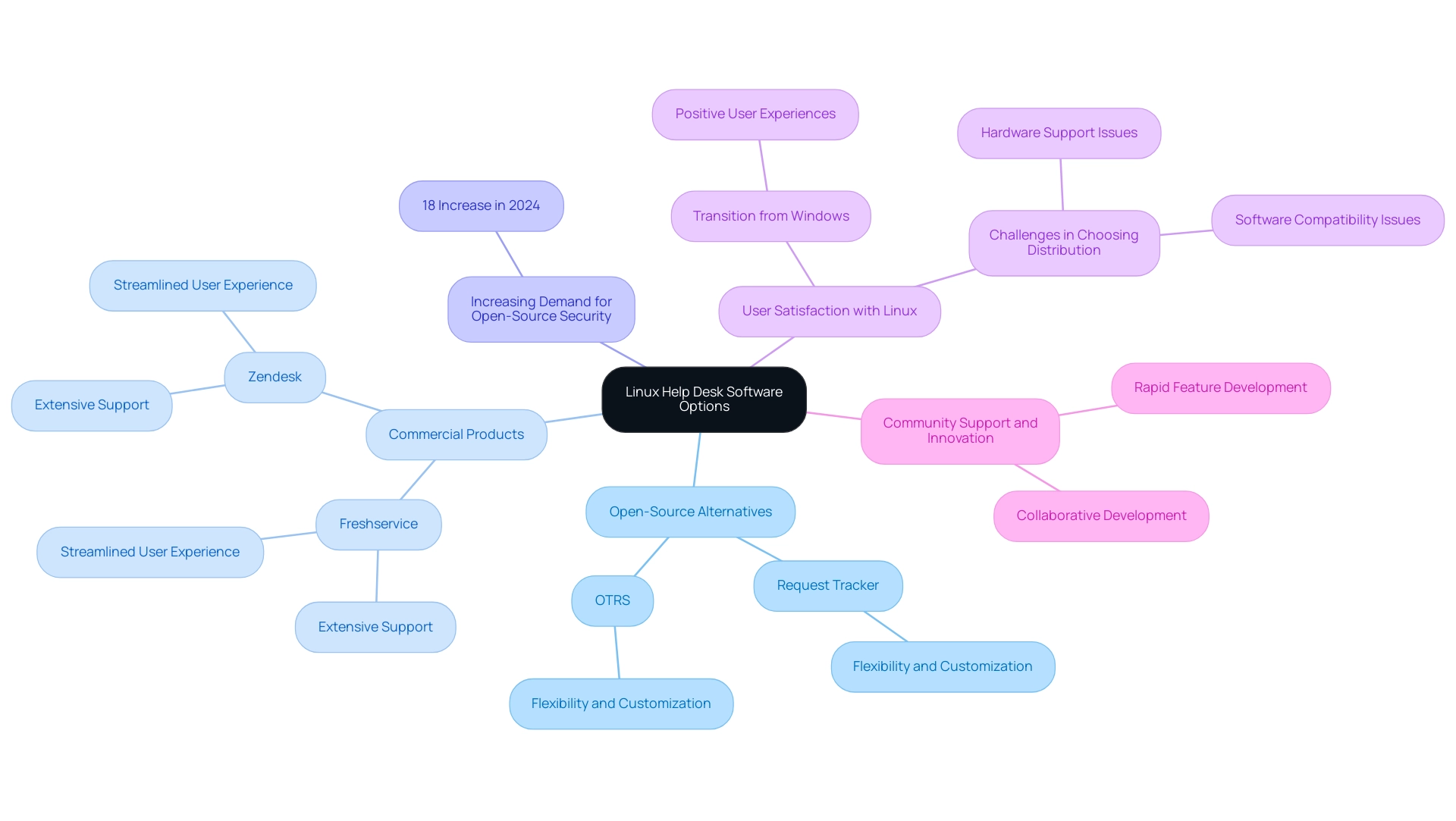
Key Features to Consider in Linux Help Desk Software
When evaluating Linux help desk software, several important characteristics deserve thorough attention. Foremost among these is the capability for effective ticket management within Linux help desk software, which is essential for tracking and resolving user issues efficiently. As 84% of consumers are ready to invest more for improved assistance, the significance of efficient support systems in boosting customer satisfaction and service quality cannot be emphasized enough.
- Automation of repetitive tasks is another critical aspect, as it streamlines workflows and enhances overall productivity.
- Additionally, customizable reporting tools allow organizations to derive insights from support activities, which can inform strategic decision-making.
- Integration with other systems, such as Customer Relationship Management (CRM) and project management tools, further enhances the utility of Linux help desk software solutions.
The user interface design plays a vital role in user adoption; software that offers an intuitive experience is more likely to see widespread use. As noted by SodaStream, "I think calling it 'royally fucking up' is a little much. But that doesn't diminish the reality that this operating system is rapidly becoming easier to install than Windows." This perspective highlights the increasing usability of open-source systems, contrasting with the more rigid installation process of Windows.
Customer support options, such as Linux help desk software, are equally important, as they can significantly influence user satisfaction. For example, a strong self-service portal enables clients to address issues on their own, thus decreasing the workload on support staff and enhancing operational efficiency. Furthermore, recent updates in operating system distributions, such as Ubuntu 24.04 LTS and Fedora 39, reflect ongoing improvements to meet modern computing needs, reinforcing the relevance of these features in fostering a responsive and effective IT support environment.
As the support system adoption ratio surged by 103% from 2016 to 2020, it is evident that organizations are increasingly recognizing the value of these features.
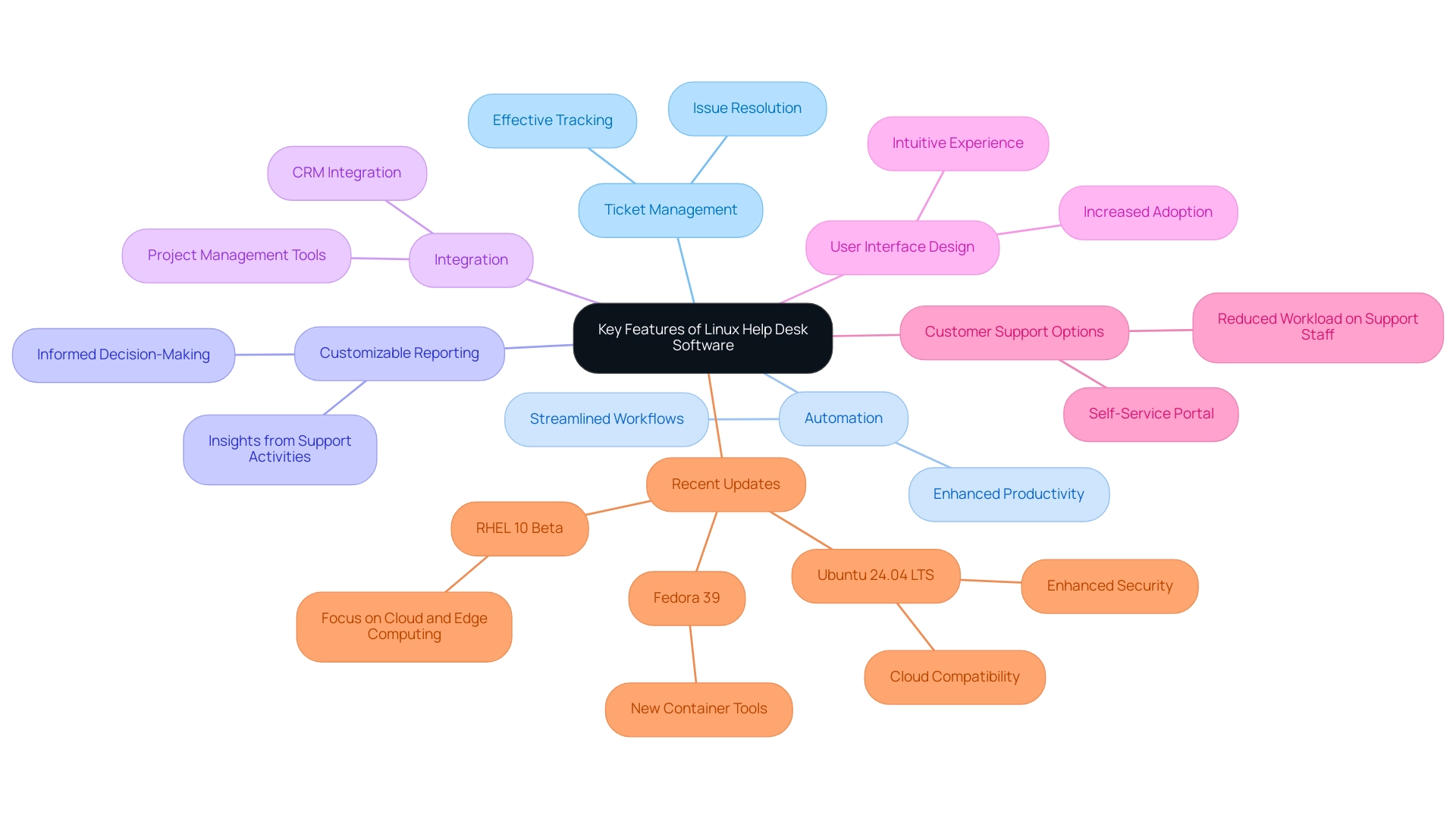
Pricing Models for Linux Help Desk Solutions
The pricing environment for Linux help desk software shows considerable variability, covering a range of models from open-source options—which are usually free to utilize but may involve expenses for support and maintenance—to subscription-based services that bill according to the number of agents or specific feature sets. For instance, Freshservice employs a tiered pricing structure that adjusts according to the number of users and required features, thereby aligning costs with organizational needs. One option is priced at $19 per user, per month, billed annually, providing a clear benchmark for organizations evaluating their budget.
In contrast, OTRS offers a free community edition that caters to smaller teams, while also providing enterprise options for larger organizations seeking advanced functionalities. As organizations assess their budgetary constraints, it is crucial to evaluate the total cost of ownership, which includes potential hidden costs related to implementation, training, and ongoing support. This comprehensive approach enables decision-makers to make informed choices that optimize both financial and operational efficiency.
Furthermore, with the focus on data safety, ScienceSoft ensures data protection through its ISO 27001-supported information security management system, which is essential for organizations considering support solutions. As noted, 'Linux help desk software facilitates managing customer support and service requests for businesses,' highlighting its essential role in resolving issues, inquiries, and complaints customers present while using a business's products or services. Moreover, the recent introduction of Red Hat Enterprise RHEL 10 Beta, which emphasizes streamlining cloud and edge computing implementations with enhanced automation capabilities, adds more significance to the conversation about support solutions in the changing IT environment.
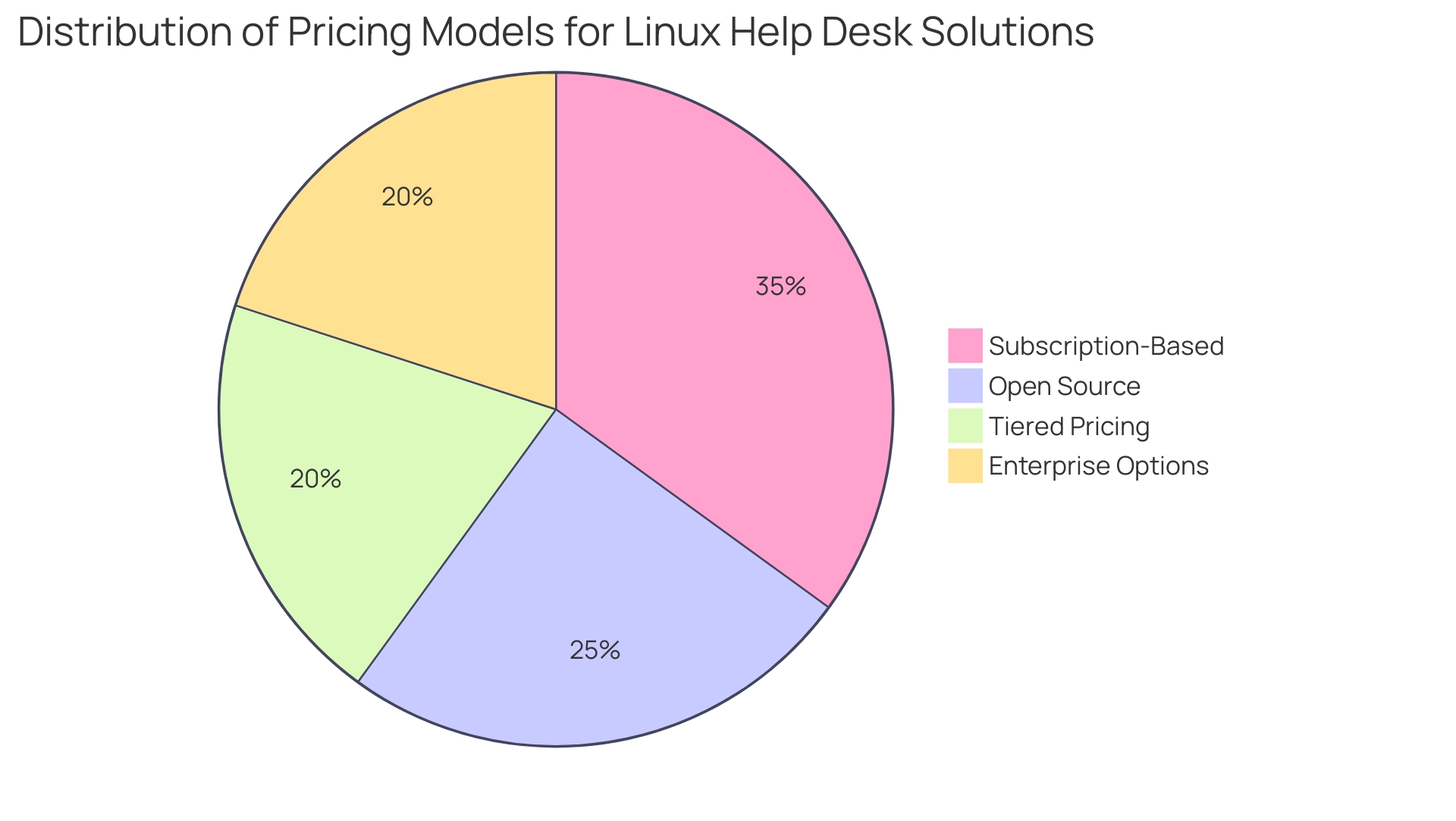
Evaluating Performance and User Satisfaction
To effectively assess the performance of Linux help desk software, organizations must consider essential factors such as user satisfaction ratings, response times, and resolution rates. Recent insights indicate that platforms like TOPdesk boast a commendable user rating of 4.5 based on 61 reviews, highlighting its effectiveness in meeting user expectations. Furthermore, analyzing reviews on platforms such as G2 and Capterra can yield valuable perspectives on a software's real-world performance.
For example, while Zendesk receives accolades for its intuitive interface and comprehensive reporting capabilities, other solutions may face criticism for their steep learning curves or insufficient support. According to NinjaOne, "NinjaOne automates the hardest parts of IT, empowering more than 20,000 IT teams. By providing deep insights into endpoints, robust security measures, and centralized control, NinjaOne boosts efficiency while safeguarding sensitive data and cutting IT expenses."
This insight highlights the significance of assessing support solutions not solely based on user ratings but also on their capacity to improve operational efficiency and security, including the use of Linux help desk software. It is vital for performance metrics to correspond with the specific needs of the organization, ensuring that the chosen solution effectively tackles support challenges. Specific performance metrics—such as average response times, which should ideally be under 24 hours, and user satisfaction metrics, with a target of 90% satisfaction—can guide decision-makers in their evaluations.
Expert opinions highlight the significance of these metrics in assessing effectiveness. An illustrative case is kwiqreply, a WhatsApp Business API and CRM Helpdesk platform that has enhanced customer interaction through automated messaging and chatbot integration, showcasing the impact of performance-focused solutions.
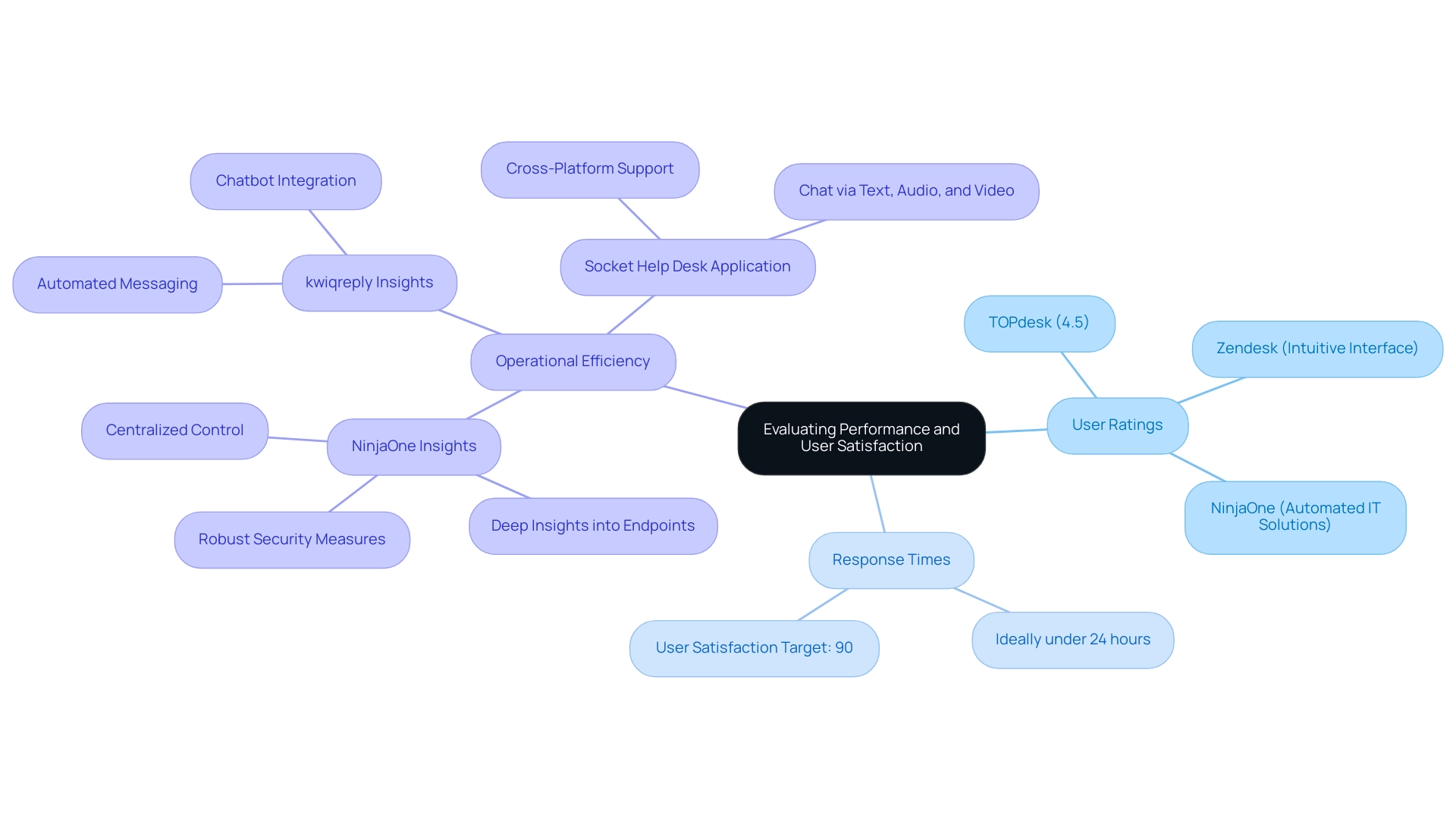
Best Practices for Choosing Linux Help Desk Software
To effectively choose Linux help desk software, organizations must start with a clear definition of their requirements, carefully evaluating how each potential solution aligns with their strategic business objectives. With over the next two years, 56% of companies anticipated having a significant portion of their support team working from home, it becomes essential to consider remote capabilities in the selection process. Implementing trials or demonstrations of the application allows teams to gain firsthand insights into its usability and functionality, which is essential for informed decision-making.
Moreover, scalability emerges as a vital factor; organizations should opt for Linux help desk software that is capable of adapting and evolving alongside their business growth. As 57% of customers are more likely to contact businesses via digital media such as email or social media rather than voice-based support, modern communication features are essential in Linux help desk software solutions. Importantly, engaging end-users and stakeholders in the selection process not only enhances the likelihood of a successful implementation but also fosters greater satisfaction and adoption across the organization.
This collaborative method ensures that the selected application comprehensively meets the diverse needs of its users, leading to a more cohesive and efficient operational environment. Additionally, referencing the case study on chatbots and natural language processing, which are projected to save businesses more than $8 billion per year, underscores the financial benefits of implementing advanced customer service technologies, reinforcing the argument for scalability and future-proofing in software selection.
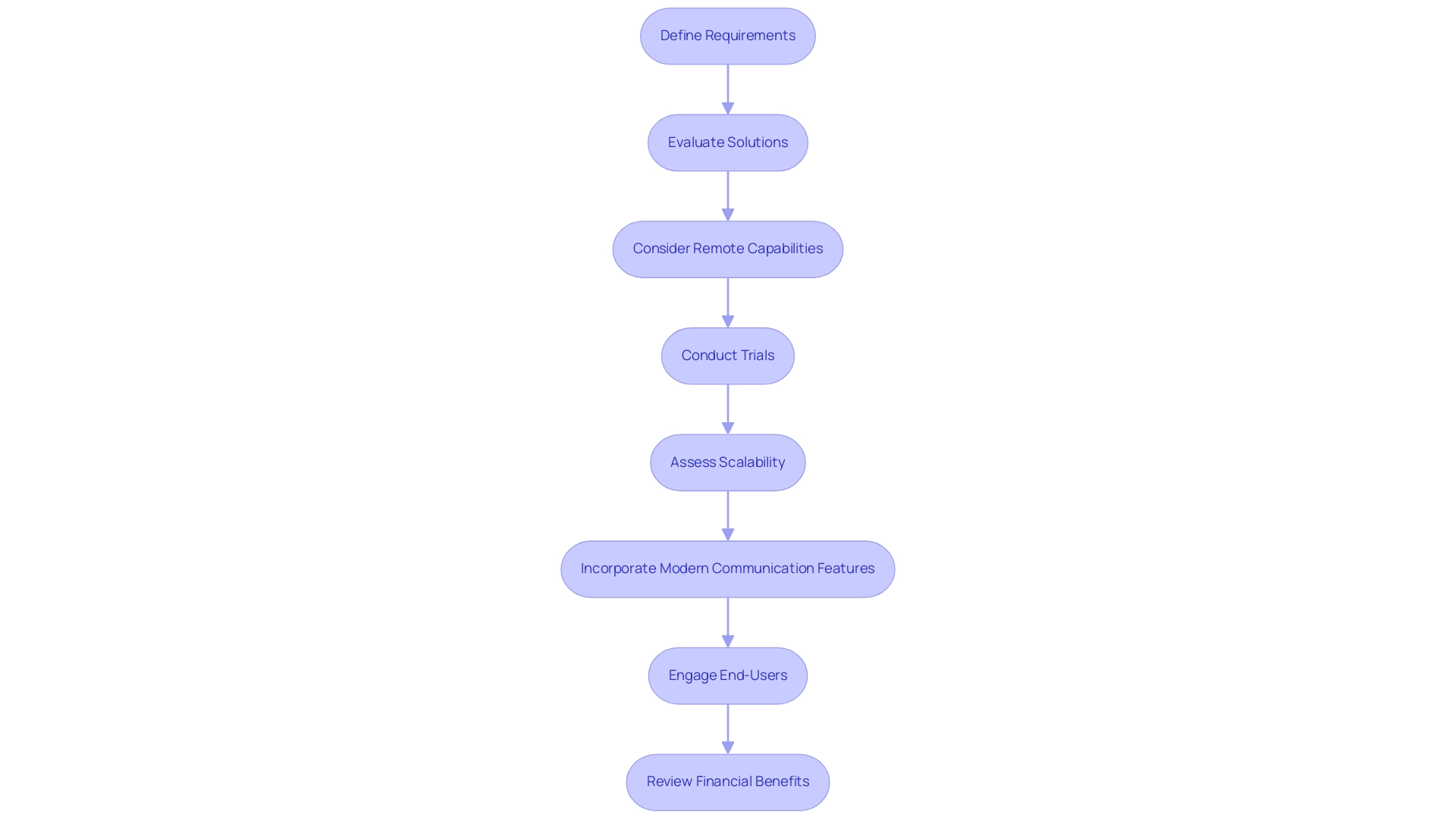
Conclusion
Selecting the appropriate Linux help desk software is a critical decision that can significantly influence an organization's operational efficiency and customer satisfaction. The diverse landscape of options, ranging from open-source solutions like OTRS to commercial products such as Freshservice, offers various features tailored to meet distinct organizational needs. Key considerations such as:
- Effective ticket management
- Automation capabilities
- Integration with existing systems
emerge as vital components in ensuring that the selected software enhances productivity and user experience.
Furthermore, understanding the pricing models is essential for organizations to align their budgetary constraints with their operational requirements. The total cost of ownership, including potential hidden costs, must be evaluated to ensure informed decision-making. Additionally, evaluating performance metrics and user satisfaction ratings provides invaluable insights into the effectiveness of chosen solutions, guiding organizations toward options that best meet their specific challenges.
Ultimately, adopting best practices in the selection process—such as:
- Defining clear requirements
- Considering remote capabilities
- Engaging stakeholders
can lead to a more successful implementation of Linux help desk software. Organizations that approach this decision strategically will not only foster a responsive and efficient support environment but also enhance overall customer satisfaction, setting the stage for long-term success in an increasingly digital landscape.




